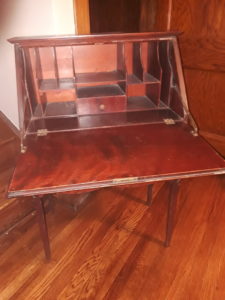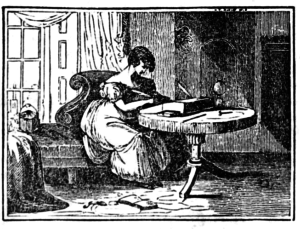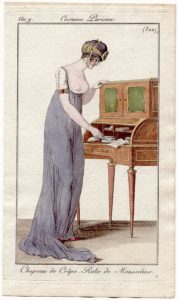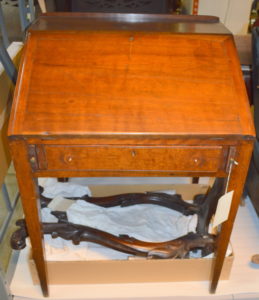Way back when, I had a job where there was, quite literally, nothing to do for weeks at a stretch. I shared an office with another woman, Joyse, who I still keep in touch with. Joyse and I sometimes spent our afternoons going to the movies or, one of my favorite pastimes, heading out to Jackson Square (this job was located in San Francisco) to hit the antique stores. I didn’t have the money to buy anything — these were very high end stores for the most part.
I’d gotten into antiquing even farther back in time when I was in a position to replace the furniture that came with my Rent Controlled furnished Berkeley apartment. Or so I thought. I discovered that new furniture was 1) most pretty ugly 2) Not very well made and 3) WAY too expensive given 1 and 2. There were antique stores less than a mile from my apartment, including Lacey’s, which has to this day an amazing collection of period fabric and dresses which they would let you look at. I wish I’d been more of a sewing geek… At any rate, I noticed that antique furniture was 1) quite often lovely 2) solidly made and 3) well within my price range.
There was, in one of these antique stores, a Georgian highboy (refinished, someone had stripped off the paint, but probably that happened in the mid-to late 1800’s) that was stunning. To this day I wish I’d scraped together the money to buy it. At any rate, I got into the habit of going to antique stores looking for furniture I wouldn’t mind having in my apartment. And I found it, slowly. I also discovered there was magic in the words “What can you tell me about this piece.” The owners who actually knew something about antiques had interesting stories about the furniture.
I talked one woman into setting up a layaway on a Georgian oak secretary/butler’s desk. My desk stayed in her store while I paid $100 a month until I had the cash to pay the balance. Which I did. The shape of the desk there to the left is essentially this, but mine is the lighter color of oak, and does not have the carving which, to be honest, looks to very Victorian to me (and possibly mahogany rather than oak). The description says 1820 which would help explain all the overdone carving, and if I were forced, just based on this picture, I’d have said 1830’s. Mine has the cubby holes and drawers, but on mine, there are two columns on either side of the middle space that are actually vertical drawers that slide out if you know where to put your fingers. Just based on this picture, I’d guess the lower drawer’s hardware is not original. Original hardware is rare, of course.
 With antique furniture, there is a smell that goes along with old wood. You can smell if something has been refinished, so it’s important to open the drawers and breathe in. Does the piece smell old? How were the drawers put together? Nails or mortice and tenon? Have interior boards been replaced? Can you smell turpentine or other chemicals? Do the pieces fit together or did someone marry two different pieces of furniture? The desk to the right shows the color mine is. It’s identified as 1790’s and that’s a date I’m comfortable with. This one has fancier legs — note the scroll shaping on the feet compared to the plainer feet of the darker one. The hardware looks more at home than the other piece, but you’d have to look inside the drawers to see if it’s original (did someone have to drill new holes for new hardware, eg) If you go here you can see additional pictures of the inside of this desk. Much finer and in keeping, in my opinion with what is a finer desk than the other. You can also see that on the hardware on the right of the middle drawer is broken – the lower bit is missing. That sort of thing happens to old furniture, by the way.
With antique furniture, there is a smell that goes along with old wood. You can smell if something has been refinished, so it’s important to open the drawers and breathe in. Does the piece smell old? How were the drawers put together? Nails or mortice and tenon? Have interior boards been replaced? Can you smell turpentine or other chemicals? Do the pieces fit together or did someone marry two different pieces of furniture? The desk to the right shows the color mine is. It’s identified as 1790’s and that’s a date I’m comfortable with. This one has fancier legs — note the scroll shaping on the feet compared to the plainer feet of the darker one. The hardware looks more at home than the other piece, but you’d have to look inside the drawers to see if it’s original (did someone have to drill new holes for new hardware, eg) If you go here you can see additional pictures of the inside of this desk. Much finer and in keeping, in my opinion with what is a finer desk than the other. You can also see that on the hardware on the right of the middle drawer is broken – the lower bit is missing. That sort of thing happens to old furniture, by the way.
Here’s another one, from the 1770’s. This one looks like it has original hardware! It’s elm, by the way, More pictures of this desk here – including the documentary evidence of 1770 as a manufacture date. If you compare these two pieces with the dark one above, you can see why I think there’s something off about that first desk. This page of Georgian desks makes that first one even odder. That desk is Georgian in shape, sort of. Look back at the first desk — its appears to be taller than the actual Georgian pieces. To me, the shape is subtly off, and the carving is completely atypical. I’d want to see that first desk in person and talk to the dealer about where they found it and hear their explanation for why a Georgian piece is so Victorian in color and sensibility. Take a look at all the other Georgian pieces. There isn’t any carving on any of them. Not a one. The more I think about it, the more suspicious I am about that first desk. Again, you’d really have to see it in person to decide. Of course a desk can be atypical for the period in which it was made, but it’s off.
As you can see, I’ve geeked out on you, but that’s part of the point of the Riskies, right?







